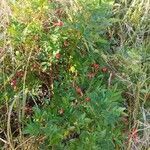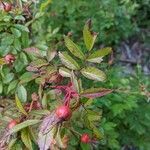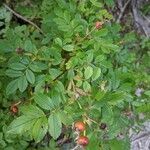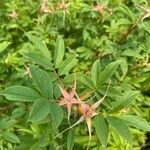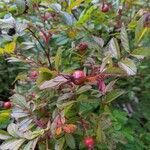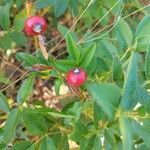Shrubs, forming thickets. Stems erect, 10–25(–30) dm, sparsely branched; bark reddish brown, glabrous; infrastipular prickles paired, curved, rarely erect, stout, 3.5–8 × 2–5(–10) mm, ?base glabrous?, internodal prickles and aciculi rare, sometimes absent. Leaves 8–11 cm; stipules ?narrow?, 10–22(–35) × 2.5–4 mm, auricles erect, rarely flared, 2.5–4.5(–8) mm, margins serrulate, eglandular or stipitate-glandular, surfaces glabrous, eglandular; petiole and rachis usually with pricklets, puberulent to pubescent, sometimes glabrous, eglandular or sparsely stipitate-glandular; leaflets 5–7, terminal: petiolule 5–10 mm, blade ovate-lanceolate, rarely broadly lanceolate or narrowly elliptic, 23–45 × 10–18 mm, membranous, base cuneate, margins 1–2-serrulate, ?eglandular?, teeth 20–30 per side, acute to ± obtuse, eglandular, apex acute to subacute, abaxial surfaces pale green, glabrous or pubescent, eglandular, adaxial green, dull, glabrous. Inflorescences corymbs, (1 or)2–10(–40)-flowered. Pedicels erect, slender, 6–15 mm, glabrous, densely stipitate-glandular; bracts 2, lanceolate, 6–15 × 3–4 mm, ?margins and central veins pubescent?, eglandular, surfaces pubescent, eglandular. Flowers 2.5–5 cm diam.; hypanthium cupulate, 2–4 × 2–4 mm, glabrous, sparsely to densely stipitate-glandular, neck absent or 1–3 mm; sepals spreading to reflexed, rarely erect, lanceolate to narrowly ovate-lanceolate, 15–30(–40) × 2–3.5 mm, tip 2.5–3.5 × 0.5–1 mm, margins entire, rarely pinnate, abaxial surfaces glabrous, densely, sometimes sparsely, stipitate-glandular; petals single, pink to deep pink, 14–28 × 13–28 mm; ?stamens 200?; carpels 24–50, styles exsert 0.5–1 m beyond stylar orifice (1.5 mm diam.) of hypanthial disc (3.5–4.5 mm diam.). Hips deep red, usually globose to subglobose, rarely elongate, 7–11 × 7–11 mm, fleshy, glabrous, sparsely or densely stipitate-glandular, neck absent or 3 × 1 mm; sepals deciduous, spreading. Achenes basal, 26, tan, 3 × 1.5–2 mm. 2n = 14.
More
Much-branched shrub to 2 m; infrastipular prickles stout, decurved, 3–6 mm, the flattened base at least half as long; internodal prickles none; stipules very narrow, scarcely widened distally; lf-rachis softly pubescent; lfls commonly 7, narrowly elliptic to oblanceolate, softly pubescent on the midrib beneath, finely serrate, the teeth usually less than 2 mm wide and avg 0.5 mm high; fls solitary or in small corymbs; pedicel and hypanthium stipitate-glandular; sep soon spreading or reflexed, then deciduous; pet pink, 2–3 cm; hips red, only 7–l2 mm thick; 2n=14. Swamps, marshes, and streambanks; N.S. to Minn., s. to the Gulf of Mexico. Evidently hybridizes with R. blanda, and probably to a lesser extent with R. carolina.
Can be grown by cuttings or seedlings. Seeds needs scarification.
